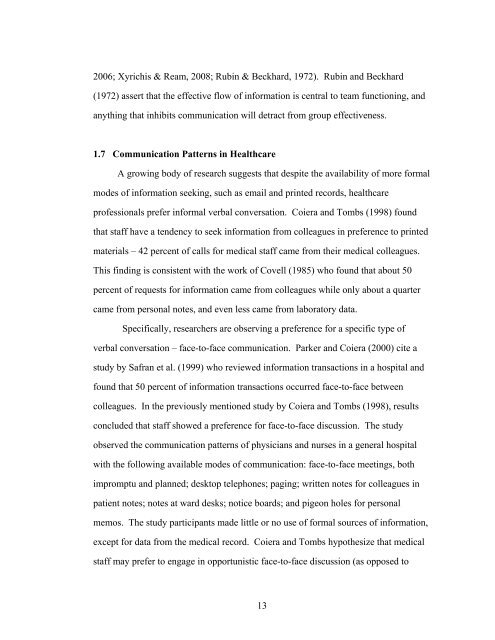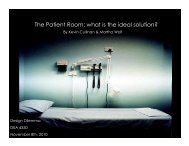The role of physical design and informal communication
The role of physical design and informal communication
The role of physical design and informal communication
You also want an ePaper? Increase the reach of your titles
YUMPU automatically turns print PDFs into web optimized ePapers that Google loves.
2006; Xyrichis & Ream, 2008; Rubin & Beckhard, 1972). Rubin <strong>and</strong> Beckhard<br />
(1972) assert that the effective flow <strong>of</strong> information is central to team functioning, <strong>and</strong><br />
anything that inhibits <strong>communication</strong> will detract from group effectiveness.<br />
1.7 Communication Patterns in Healthcare<br />
A growing body <strong>of</strong> research suggests that despite the availability <strong>of</strong> more formal<br />
modes <strong>of</strong> information seeking, such as email <strong>and</strong> printed records, healthcare<br />
pr<strong>of</strong>essionals prefer <strong>informal</strong> verbal conversation. Coiera <strong>and</strong> Tombs (1998) found<br />
that staff have a tendency to seek information from colleagues in preference to printed<br />
materials – 42 percent <strong>of</strong> calls for medical staff came from their medical colleagues.<br />
This finding is consistent with the work <strong>of</strong> Covell (1985) who found that about 50<br />
percent <strong>of</strong> requests for information came from colleagues while only about a quarter<br />
came from personal notes, <strong>and</strong> even less came from laboratory data.<br />
Specifically, researchers are observing a preference for a specific type <strong>of</strong><br />
verbal conversation – face-to-face <strong>communication</strong>. Parker <strong>and</strong> Coiera (2000) cite a<br />
study by Safran et al. (1999) who reviewed information transactions in a hospital <strong>and</strong><br />
found that 50 percent <strong>of</strong> information transactions occurred face-to-face between<br />
colleagues. In the previously mentioned study by Coiera <strong>and</strong> Tombs (1998), results<br />
concluded that staff showed a preference for face-to-face discussion. <strong>The</strong> study<br />
observed the <strong>communication</strong> patterns <strong>of</strong> physicians <strong>and</strong> nurses in a general hospital<br />
with the following available modes <strong>of</strong> <strong>communication</strong>: face-to-face meetings, both<br />
impromptu <strong>and</strong> planned; desktop telephones; paging; written notes for colleagues in<br />
patient notes; notes at ward desks; notice boards; <strong>and</strong> pigeon holes for personal<br />
memos. <strong>The</strong> study participants made little or no use <strong>of</strong> formal sources <strong>of</strong> information,<br />
except for data from the medical record. Coiera <strong>and</strong> Tombs hypothesize that medical<br />
staff may prefer to engage in opportunistic face-to-face discussion (as opposed to<br />
13







